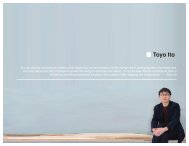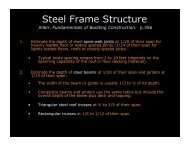Villa VPRO â Kabota - GD1 Studio Fall 2012
Villa VPRO â Kabota - GD1 Studio Fall 2012
Villa VPRO â Kabota - GD1 Studio Fall 2012
- No tags were found...
Create successful ePaper yourself
Turn your PDF publications into a flip-book with our unique Google optimized e-Paper software.
MVDRV is a young firm based in the Netherlands thatspecializes in a pragmatic approach do design. They bring amassive amount of both quantitative and qualitative research tobear on all of their projects, and from this research they distill anumber of parameters that they call a “datascape” which formsthe basis for the design.For <strong>Villa</strong> <strong>VPRO</strong>, the project entailed bringing together the12 separte “villas” that made up the various arms of the <strong>VPRO</strong>network, including TV, radio, and other programming, all intoone central office building. This meant that the project wouldhave to be an efficient, centralized space, but would also have tomaintain some of the diversity and separation accorded by theold villa offices.Climactic considerations in Hilversumwere not particularly demanding; MVRDVat first proposed installing hot air blowers atthe edges of the building instead of windowsto maintain a comfortable temperature in themild climate, but zoning did not allow it. Thisresulted in 27 kinds of glass reflecting interiorprogram.In constructing the datascape, programmaticneeds for a large, diverse office spaceneeded to mesh with Dutch zoning code limitingheight to five stories and mandating accessto natural light and outdoor space for workers.the small site resulted in “the deepest officebuilding in the Netherlands,” a dense fivestory cube punctured by voids that broughtin both natural light and a variety of outdoorspaces. This void-making strategy was named“precision-bombing,” probably reflecting thepunctures they created in the “landscape” (seebelow) of the building.continuedAn MVRDV diagram of the building as ageological formation, terminating at a secondground level that meets the sky
While MVRDV likes to appearagnostic in terms of architectural ideology,it is probably fair to say that<strong>Villa</strong> <strong>VPRO</strong> incorporates a numberof loosely related architectural ideasthat are visible throughout. The nextsection will explore some of these inmore depth through sketching, but Iwill underline the ideas that I followedthroughout my exploration ofthe building:“precision bombing”utility coresfloor as facadea Spartan language of solid concreteslabs and minimally invasive glasssketch modelThis model helped to understandthe structural and organizationallogic of the building, especiallywhere service and plumbing coresran thourgh the building (visible asorange and yellow sections), as wellas the “precision bombing” used tocreate verandas, balconies and otheroutdoor spaces (the cut out sectionsthat pierce through the solid of thebuilding.
Condition sketchesThese sketches were used to study moments in <strong>Villa</strong> <strong>VPRO</strong> that related to thearachitectural ideas and decision making process that went into the building.Section showingfootingMeeting the Ground<strong>Villa</strong> <strong>VPRO</strong> sets up a language of the floor simply continuingthe plane of the ground for most of the building,but makes an expection for the recording studios (thesection with a concrete bearing wall) where the buildingsinks into the topography. This continues the idea of thebuilding as extruded landscape.Perspective showing both ways ofmeeting the ground: sunk in andinhabiting the same planeexploded axon trying tounderstand the footingElevation view of how the concretesection sits in the topography whilethe glass section merges with it
Making the CornerPlan, floor 3interior corner conditionPlan, floorextrior corner balconyPerspective of the corner balcony. combined withthe “precision bombing,” these spaces ensure all occupantshave easy access to the outside. Also noticethat the floors create the coninuous pattern of thefacade, rather than the spaces between them.Perspective showing various ways of makingthe corner - completely enclosed,partially pulled back, and completely open
Making the Walland the OpeningWall section showing howmullions are recessed andinsulation is manipulated tokeep a spartan appearance ofsolid slabs spanned by glassPerspective looking out.MVRDV puts in considerable effort intorecessing mullions to keep the appearance ofa continuous surface running to the edge ofthe building. The wall is the opening is thespace between floors.The floor is the facadeThe windows are the wall
Meeting the SkyDetail of the roof composition.Again, effort is put in to make this complex systemlook like a simple concrete slab - even the flashingtries to continue the line of the precast facing to createa continuous surface meeting the sky.floor slabs simply continue until the building stops. No specialmoves to meet the sky except flashing, which is minimizedThe railing on the roof is pulledback to preserve the appearanceof floor slab meeting sky
Sketches for Final ModelSketches done with the help of a consultant to understandhow structure comes through the thickened section of thejoint visible in the center of the photo below rightStudying the triangular jointsand how where the interior andexterior of the precast concretepanels work
deconstructing the section from an exteriorphoto - the logic of keeping the confusion ofthe meeting of orthagonal and diagonal hiddenfrom view
Final model:Meeting the Sky
typical roof sectionwhere rebar structure comes through the angled slabAfter sketching how <strong>Villa</strong> <strong>VPRO</strong> meets the sky fromvarious angles and drawing types, it seemed that thehardest to understand, but most interesting momentoccurred at the meeting of the regular building logic(column meets floorplate) with a portion of “precisionbombing” where the regular roof is gone, replacedby a plane that angles back toward the interior workingwith photos and incomplete section drawings ofthe condition, I tried to work out how structure camedown through the angled portion of the roof.The key was the thickened part of the joint connectingthe flat roof to the angled slab. This kindof thickening wasn’t part of the language of the restof the building, so there must have been a significantreason to make such a change. I decided thatthis must be where a bundle of rebar connected theroof structure in the flt roof , then stepped down andcarrried through the angled slab. This kind of jointwould also allow the precast concrete panels aboveand below it to maintain their regular function offorming the facade and meeting the sky.worm’s eye view of structure and columfacade view from outside






